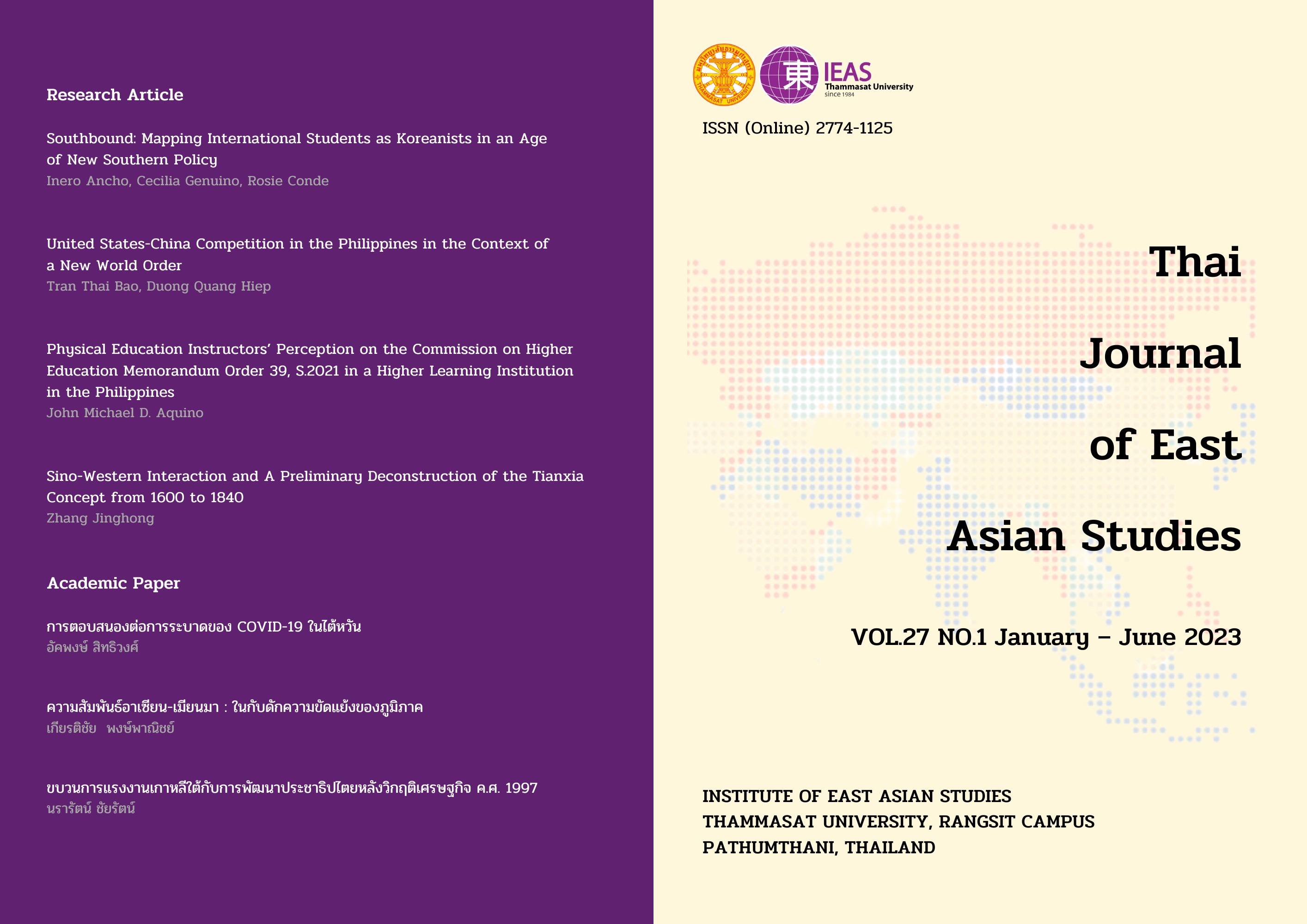Physical Education Instructors’ Perception on the Commission on Higher Education Memorandum Order 39, S.2021 in a Higher Learning Institution in the Philippines
คำสำคัญ:
Physical education, CHED Memorandum Order 39, Physical education instructors, Outcome-based education (OBE), Student learning outcomesบทคัดย่อ
The Commission on Higher Education (CHED) issued Memorandum Order (CMO) No. 39, Series of 2021 in the Philippines to strengthens the management of physical education teachers and promotes achievement of student learning outcomes by providing rules, standards and recommendations for physical education (PATHFIT) at the tertiary level. It outlines causes and objectives of changes in course environment aligned with revised general education curriculum as outlined in CMO 20, Series of 2013. This research assesses perceptions of physical education instructors (PEIs) about CMO 39. The goal is to evaluate its advantages and disadvantages based on respondent feedback. Also investigated was the implementation process in PE classes to understand potential effect on student learning outcomes. Qualitative research was done with narrative inquiry and purposive sampling with respondents being 12 PEIs at a higher learning institution. Data was gathered by face-to-face interviews, using the validated interview guide. Results indicated positive and negative perceptions of PEI in CMO 39, s.2021, which permits teachers to provide engaging activities for students, encouraging them to work to master subjects. It also helps universities meet CHED standards and offers students comprehensive education tailored to individual needs. Seminars and workshops may help teachers prepare for successful implementation of new curriculum. Guiding and supporting students is essential for success in physical education.
Downloads
เอกสารอ้างอิง
Alemi, M., Meghdari, A., & Ghazisaedy, M. (2015). The impact of social robotics on L2 learners’ anxiety and attitude in English vocabulary acquisition. International Journal of Social Robotics, 7(4), 523-535.
Alismail, H. A., & McGuire, P. (2015). 21st century standards and curriculum: Current research and practice. Journal of Education and Practice, 6(6), 150-154.
Alshenqeeti, H. (2014). Interviewing as a data collection method: A critical review. English linguistics research, 3(1), 39-45.
Aquino, J. M. (2022). Students’ evaluation in the developed video-based learning materials for physical education in Higher Education Institutions (HEIs). Edu Sportivo: Indonesian Journal of Physical Education, 3(2), 111-124.
Bean, J. C., & Melzer, D. (2021). Engaging ideas: The professor's guide to integrating writing, critical thinking, and active learning in the classroom. John Wiley & Sons.
Campbell, S., Greenwood, M., Prior, S., Shearer, T., Walkem, K., Young, S., ... & Walker, K. (2020). Purposive sampling: complex or simple? Research case examples. Journal of research in Nursing, 25(8), 652-661.
Commission of Higher Education. (2013). General Education Curriculum: Holistic Understandings, Intellectual and Civic Competencies, (CMO 20), S. 2013 (Phil.). https://ched.gov.ph/wp-content/uploads/2017/10/CMO-No.20-s2013.pdf
Commission of Higher Education. (2021). Policies, Standards and Guidelines on the Implementation of Tertiary Physical Education: Physical Activity towards Health and Fitness (PATHFIT) Course, (CMO 39), s. 2021. https://tinyurl.com/dwmhvzu2.
Darling-Hammond, L. (2013). Performance-based assessment and educational equity. In Etta R. Hollins (Ed.) Transforming curriculum for a culturally diverse society (pp. 245272). Routledge.
Elo, S., Kääriäinen, M., Kanste, O., Pölkki, T., Utriainen, K., & Kyngäs, H. (2014). Qualitative content analysis: A focus on trustworthiness. SAGE open, 4(1), 1-10. https://doi.org/10.1177/2158244014522633
Erstad, O., & Voogt, J. (2018). The twenty-first century curriculum: issues and challenges. Springer International Handbooks of Education, 19-36. https://link.springer.com/referenceworkentry/10.1007/978-3-319-71054-9_1
Frasso, R., Keddem, S., & Golinkoff, J. M. (2018). Qualitative methods: tools for understanding and engaging communities. In R. A. Cnaan & C. Milofsky (Eds.), Handbook of community movements and local organizations in the 21st century (pp. 527-549). Springer, Cham.
Gould, D., & Voelker, D. K. (2012). Enhancing youth leadership through sport and physical education. Journal of Physical Education, Recreation & Dance, 83(8), 38-41.
GOVPH. (1987). The Constitution of the Republic of the Philippines. https://www.officialgazette.gov.ph/constitutions/1987-constitution/
Horsfall, M., Eikelenboom, M., Draisma, S., & Smit, J. H. (2021). The effect of rapport on data quality in face-to-face interviews: Beneficial or detrimental?. International Journal of Environmental Research and Public Health, 18(20), 10858. https://doi.org/10.3390/ijerph182010858
Maxkamovich, A. Y., & Abdukahorovich, S. K. (2019). Modern approaches to the content of physical education of schoolchildren in the continuing education system. European Journal of Research and Reflection in Educational Sciences, 7(12), 17-21.
Mikecz, R. (2012). Interviewing elites: Addressing methodological issues. Qualitative inquiry, 18(6), 482-493.
Pathak, V., Jena, B., & Kalra, S. (2013). Qualitative research. Perspectives in clinical research, 4(3), 192. https://doi.org/10.4103/2229-3485.115389
Rosenthal, M. (2016). Qualitative research methods: Why, when, and how to conduct interviews and focus groups in pharmacy research. Currents in pharmacy teaching and learning, 8(4), 509-516.
Santos, M., Martin, J., Mhico Sigua, E., & Manuel, S. (2022). Effects of Online Teaching on Perceived Physical Competence and Cultural Appreciation of the Philippine Martial Arts “Arnis”. Ido Movement for Culture. Journal of Martial Arts Anthropology, 22(5), 48-54.
Velez, L. (2023). Explicit instruction in fitness exercise for PATHFit II (physical activities towards health and fitness). Indonesian Journal of Research in Physical Education, Sport, and Health (IJRPESH), 1(1), 30-43.
Watson, D. L., & Clocksin, B. D. (2012). Using physical activity and sport to teach personal and social responsibility. Human kinetics.
Williamson, B. (2013). The Future of the Curriculum: School Knowledge in the Digital Age. MacArthur Foundation Reports on Digital Media and Learning. MIT Press. https://direct.mit.edu/books/oa-monograph/3699/The-Future-of-the-CurriculumSchool-Knowledge-in
Yli-Piipari, S. (2014). Physical education curriculum reform in Finland. Quest, 66(4), 468-484.
Young, M. (2014). Curriculum theory: what it is and why it is important. Cadernos de Pesquisa, 44, 190-202.
Yusoff, M. S. B. (2019). ABC of content validation and content validity index calculation. Resource, 11(2), 49-54.
ดาวน์โหลด
เผยแพร่แล้ว
รูปแบบการอ้างอิง
ฉบับ
ประเภทบทความ
สัญญาอนุญาต
ลิขสิทธิ์ (c) 2023 Thai Journal of East Asian Studies

อนุญาตภายใต้เงื่อนไข Creative Commons Attribution-NonCommercial-NoDerivatives 4.0 International License.



